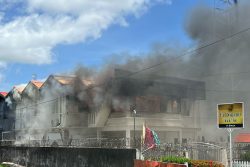Around 10:45 am on Wednesday last at Lusignan, East Coast Demerara, a truck driven by a 28-year-old man crashed into a utility pole, hit a car and then smashed into a house, causing significant destruction. Eyewitnesses told this newspaper that the truck driver was speeding when he hit the electricity pole, and the momentum which propelled his vehicle into two more objects seemed to also suggest that this was the case. The police later said that both the truck driver and the woman whose car he hit were conscious when they were rescued and taken to the Georgetown Public Hospital.
Unfortunately, the frequency with which these types of incidents occur have rendered them almost commonplace. They don’t feature at the top of the news on television or radio. They will not fill more than a few column inches in the dailies. Their only lasting impact will be on those directly involved; the injured and their families and those who suffer loss or damage as a result.
What caused a stir, as regards the incident referred to above, was a video of the rescue of the truck driver. As has also become the norm, quite a few passersby and witnesses rushed to the scene in the wake of the crash and at least half of them whipped out their cellphones and began recording. The video that subsequently went viral captured the efforts of the emergency medical technicians (EMTs) who stabilised the trapped driver before he was removed from the crumpled cab of the truck.
There was one young woman in particular whose heroics had all eyes riveted. She was forced to clamber up the front of the cab, quite a few feet off the ground to reach the injured man. With scarcely a foothold, this EMT wedged her body into the smashed surface as she needed both hands to tend to him, at one point, someone was actually supporting her leg. Her colleague remained on the ground, straining up to place the items she required into her hands. It was gobsmacking; almost like watching a dramatic movie except for the awareness that there was no safety net.
One of the questions that arose immediately after viewing this video was, where were the rest of the emergency personnel? Of course, the obvious answer plays out at nearly every crash site. Police officers arrive on the scene, sometimes before or in tandem with EMTs. Usually, there are no other emergency vehicles. The fire service rarely gets involved, unless specifically summoned in the event that there is also a fire or public-spirited citizens have not managed to wrench doors open and rescue victims as is the rule rather than the exception in Guyana.
It is worth noting here that it is a toss up as to whether these well-meaning volunteers do more harm than good. Understandably, there is that instinct to help when one witnesses or happens on a vehicular crash. There is the perception that the sooner the injured receive medical attention, the better. However, unfortunate handling by the medically untrained, particularly without the necessary Personal Protective Equipment, has been known to exacerbate injuries.
Last Wednesday’s crash site was one where a crane or ladder would have made the young first responder’s job easier and her stance less precarious. She also would have been able to stabilise the injured man that much faster. This by no means takes anything away from the truly professional way in which she completed the task, while placing herself at risk for a fall.
Working as an EMT is no joy ride anywhere in the world. In Guyana, given the conditions, to call it extremely stressful is clearly an understatement. It is also a grossly underpaid job and the people who sign up and carry out their duties with aplomb are unsung heroes.
That being said, the government needs to act on bringing the entire emergency response system into the current century, as it appears to be stuck in a time warp. All first responders, including police and firefighters, should be trained as EMTs. There should also be an expansion of the current training of EMTs to the level of paramedics so that they are qualified to perform more advanced and life-saving procedures and offer higher levels of care. Further, teams responding to vehicular crashes where injuries are reported should be fully equipped with all the necessary paraphernalia and should include all sectors of the emergency services. After an on-site inspection, whichever responders are not needed can then leave. This would obviate the ever-present clusters of civilian ‘experts’, as altruistic as their efforts might be.
Ideally a skilled and efficient emergency response should be in place before the new, modern and state-of-the-art hospitals that are being built become operational. Health care does not begin when a patient enters a facility. It is stupefying that after years and years of astoundingly huge budgets, the latest being this year’s $1.382 trillion, social and human development remain stultified, while massive sums are doled out on infrastructure projects. So much for progress.









